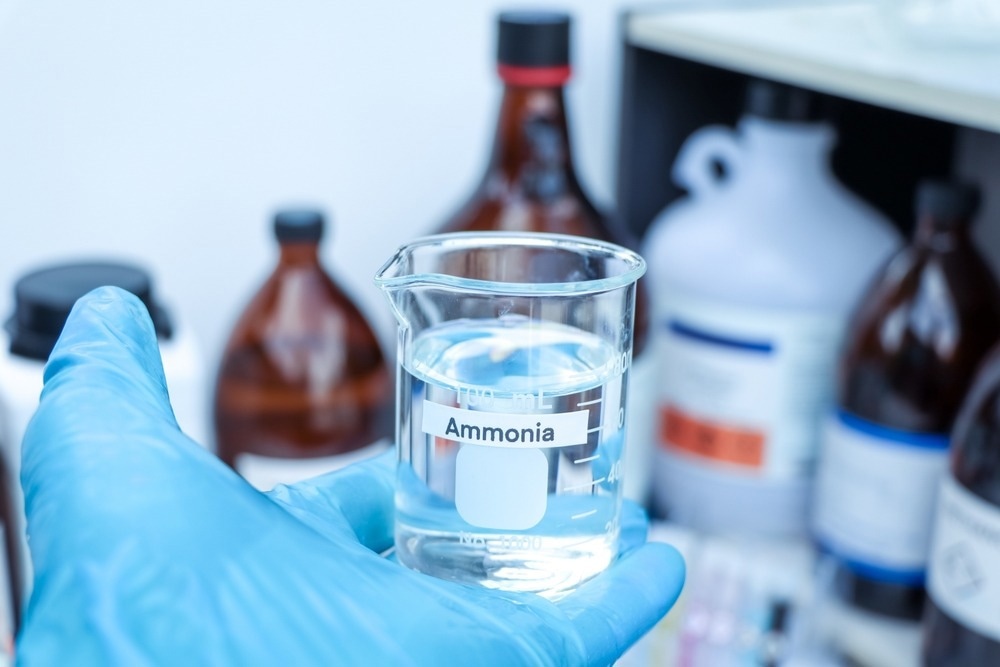In a study published in Advanced Science, a research group led by Hao Li from Tohoku University’s Advanced Institute for Materials Research (WPI-AIMR) focused on the electrochemical conversion of nitrate (No3-) to ammonia (NH3). The study revealed a process that has the potential to revolutionize industrial practices while also providing new insights into the development of efficient and sustainable catalysis processes.

Image Credit: chemical industry/Shutterstock.com
Ammonia, which has a $67 billion market value and a global market size of over 175 million tons, is essential to both industrial development and food production. It also has a high energy density, which makes it an important component of the developing hydrogen economy. The drawback of the way ammonia is currently produced is that synthesis mostly depends on the energy-intensive Harber-Bosch process, which emits a lot of CO2.
Unlike the nitrogen reduction reaction (NRR), which requires breaking the strong N=N triple bond in nitrogen (N2), nitrate reduction (NO3RR) offers a more efficient pathway. Nitrate has a much lower dissociation energy and higher solubility in water, making it easier to use as a nitrogen source for ammonia production. This not only enhances the efficiency of the process but also addresses the environmental challenge of nitrate accumulation in water systems.
Hao Li, Associate Professor and Junior Principal Investigator, Advanced Institute for Materials Research, Tohoku University
Li and his colleagues created a spherical copper (II) oxide (CuO) catalyst characterized by the stacking of tiny particles with oxygen-rich vacancies. This catalyst significantly increased ammonia production, obtaining 15.53 mg h-1 mgcat-1 and a Faraday efficiency of 90.69% in a neutral electrolyte at a voltage of -0.80 V (compared to a reversible hydrogen electrode).
The CuO electrodes’ high catalytic activity was also discovered to be due to structural and phase changes that occur throughout the electrochemical reduction process.
Our research indicates that the transformation of CuO to a Cu/Cu(OH)2 structure during the reaction process is key to the catalyst's performance. This phase change not only increases the number of active sites but also improves electron transfer at the electrode surface, enhancing the efficiency of the nitrate reduction reaction.
Qiuling Jiang, Study Co-Author and Joint PhD Student, Advanced Institute for Materials Research, Tohoku University
Furthermore, the team used density functional theory (DFT) computations to understand the catalytic process better. These simulations demonstrated that the production of Cu(OH)2 lowers the energy barrier for nitrate adsorption, making the process more efficient. Furthermore, the Cu(OH)2 phase was shown to impede the competitive hydrogen evolution reaction, but the presence of Cu (111) crystal surfaces aided in the hydrogenation process.
Li added, “This research offers a new perspective on the design of copper-based catalysts for electrocatalytic ammonia production. By controlling the reaction conditions and understanding the phase transitions, we can optimize the catalyst’s performance, potentially leading to more efficient and scalable ammonia synthesis processes.”
Looking ahead, the team intends to investigate the elements that impact the catalyst’s phase transitions throughout the reduction process. By improving the designs of these catalysts, researchers hope to improve their stability, activity, and selectivity, bringing the goal of sustainable ammonia production closer to reality.
Journal Reference:
Li, J., et. al. (2024) Surface Structure Reformulation from CuO to Cu/Cu(OH)2 for Highly Efficient Nitrate Reduction to Ammonia. Advanced Science. doi.org/10.1002/advs.202404194